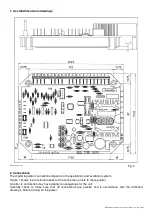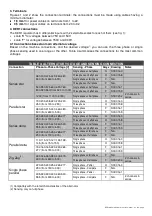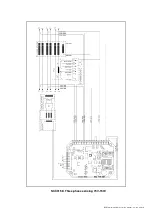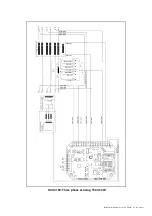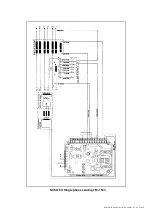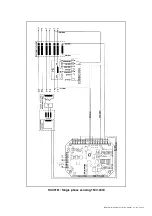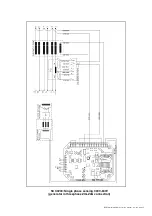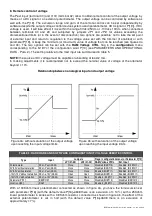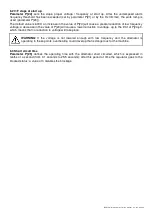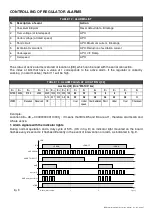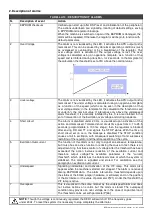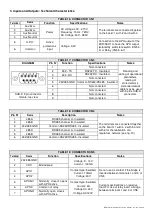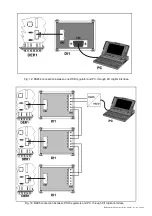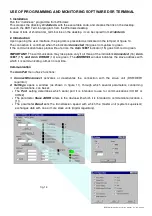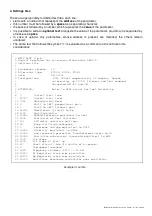
DER1 digital regulator instruction manual - rev. 03 - pag. 21
The parameter P[9] sets the excitation current limit: the value P[9]=0 is setting to zero the excitation
current, while the maximum value P[9]=32767 is removing the current limitation. The default value is P[9]
=32767. When the interval of action of the soft start has been exceeded, the output voltage moves to the
value set. The rapidity of the change is set by parameter P[18] (see paragraph on "Slow voltage
variations”)
1.2 Soft Start
In the event of fast start up of the prime mover or sudden regulator excitation with the generator running at
nominal speed an uncontrolled regulator could result in a temporary generator overvoltage or in a
transitory prime mover overload due to the high peak of excitation current..
These effects can be minimised by setting parameter P[8] and P[9] appropriately. In the phase of start up,
they determine a limit of the excitation current.
Parameter P[8] sets the duration of the excitation current limitation, namely the value of the
parameter corresponds to the number of periods in which the limitation is active. The default
value is P[8]=0 which corresponds to deactivation of the soft start. Considering that in most cases
the alternator is already at nominal speed, an estimate in temporal terms may be obtained with
the formula:
SETTING OF VOLT, STAB, AMP and Hz PARAMETERS.
1. Voltage
1.1 Setting voltage.
Setting can take place through the trimmer or software: on sensing inputs 6/7 – 10/11/12 (with bridge 8-9),
15-16 and 20-21, the voltage can be set between 75÷150 Vac (scale H); on sensing inputs 4/5 -
9/10/11/12, 14-17 and 19-22 between 150÷300 Vac (scale F).
There are two ways to set from minimum to maximum value:
1. With the VOLT trimmer, which must be enabled by the Configuration menu
2. With parameter P[19] (The Volt trimmer must be enabled from the Configuration menu: the value 0
corresponds to minimum voltage, 16384 corresponds to the intermediate value (respectively 112.5 V
and 225 V), while 32767 corresponds to maximum voltage.
It is possible to vary voltage with respect to the value set, with the Pext input (terminals 29-30) if enabled
from the
Configuration
menu, with a 25Kohm or 100Kohm potentiometer, with a range of variation that
can be programmed up to ±100% (parameter P[16]. The default setting is ± 14%, even if it is opportune
not to exceed ±10%). Alternatively, variation can be made with continuous voltage applied on Pext
(terminal 30) or ±10V (terminal 32), based on the value of that voltage. If the Pext voltage is disabled, it is
possible to vary the voltage with parameter P[15] or location L[49]. For additional details see the
paragraph "Remote control of voltage".
Where f
n
= nominal frequency in Hz or
ω
n
= nominal speed in R.P.M
n
n
P
f
P
t
ω
30
]
8
[
1
]
8
[
lim
⋅
=
⋅
=
By way of example, for high power alternators of the ECO46 series, the following settings may be
experimented: P[8]=64 and P[9]=16384; for low power alternators of the ECO/ECP3 series, the effects of a
reduction of both the duration and limitation of the current may be experimented, such as P[8]=16 and P[9]
=4096.
The optimal values of parameters P[8] and P[9] depend a great deal on the type of alternator
and final application and it must be found through experimentation. An inappropriate setting of
parameters P[8] and P[9] could cause failure of the alternator to excite itself.
Summary of Contents for DER1
Page 10: ...DER1 digital regulator instruction manual rev 03 pag 10 SCC0158 Three phase sensing 75V 150V...
Page 11: ...DER1 digital regulator instruction manual rev 03 pag 11 SCC0159 Three phase sensing 150V 300V...
Page 12: ...DER1 digital regulator instruction manual rev 03 pag 12 SCC0160 Single phase sensing 75V 150V...
Page 13: ...DER1 digital regulator instruction manual rev 03 pag 13 SCC0161 Single phase sensing 150V 300V...
Page 14: ...DER1 digital regulator instruction manual rev 03 pag 14 SCC0202 Single phase sensing 300V 600V...

